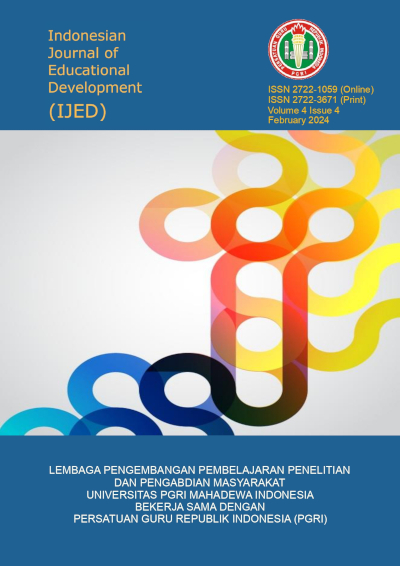THE CORRELATION BETWEEN STUDENT’S MOTIVATION AND THEIR READING COMPREHENSION AT ELEVENTH GRADE OF SMAN 1 RAJABASA
DOI:
https://doi.org/10.59672/ijed.v5i3.4142Keywords:
Motivation, Reading, Comprehension, Quantitative, QuestionnaireAbstract
There are many factors that can influence reading comprehension. Reading motivation and comprehension are two key aspects in creating successful readers. The purpose of this study is to investigate the correlation between student’s motivation and their reading comprehension at eleventh grade of SMAN 1 Rajabasa and to find out the problems faced by the students during the reading process. 30 students of class 11 Merdeka 2 were sampled for data collection. Data were collected using the MRQ questionnaire, reading test and interview. Pearson product moment correlation was used to determine the correlation and strong relation between student’s motivation and reading comprehension which was 0.685. Then, the interview data shows that there are several problems that usually faced by students, such as vocabulary with double meaning and also a noisy environment.
Downloads
References
Hardiyanto, W., Triatmanto, B., & Manan, A. (2019). The effects of working motivation, individual characteristics and working environment on employees job satisfaction. The International Journal of Social Sciences and Humanities Invention, 6(1), 5256–5260. https://doi.org/10.18535/ijsshi/v6i1.09
Kamila, K. (2022). Meningkatkan budaya literasi membaca dan menulis siswa melalui pembiasaan di kelas. Indonesian Journal of Educational Development (IJED), 3(3), 330-340. https://doi.org/10.5281/zenodo.7365136
Marbun, I, S. (2016). The correlation between motivation and student’s achievement in reading comprehension at SMP Negeri Grade VIII Pematangsiantar. JETAFL, 2, 27–38.
Mulyawan, I. N. R. & Sudewi, I. G. A. A. K. (2023). Efforts to increase learning motivation through group guidance services using group discussion techniques for students of SMPN 9 Denpasar. Indonesian Journal of Educational Development (IJED), 4(1), 58-66. https://doi.org/10.59672/ijed.v4i1.2700
Ningrum, S., & Matondang, S. A. (2017). The correlation between students’ motivation and achievement in reading comprehension. The International Journal of Social Sciences and Humanities Invention, 5(7). https://doi.org/10.18535/ijsshi/v4i7.10
Oktawidya Wati, S. (2021). The correlation between students’ reading habit and their writing ability. Jurnal Kepemimpinan dan Pengurusan Sekolah, 6(2), 157–161. https://doi.org/10.34125/kp.v6i2.621
Purnadewi, G. A. A., Arnawa, N., & Tatminingsih, S. (2023). The influence of school culture, learning interest, and learning motivation on science learning outcomes. Indonesian Journal of Educational Development (IJED), 4(2), 126-138. https://doi.org/10.59672/ijed.v4i2.3040
Parupalli, Srinivas. (2019). The importance of speaking skills in english classrooms. Alford Council of International English & Literature Journal(ACIELJ), 2(2), 9. https://www.researchgate.net/publication/334283040_THE_IMPORTANCE_OF_SPEAKING_SKILLS_IN_ENGLISH_CLASSROOMS/link/5d21b2db458515c11c18dbf3/download?_tp=eyJjb250ZXh0Ijp7ImZpcnN0UGFnZSI6InB1YmxpY2F0aW9uIiwicGFnZSI6InB1YmxpY2F0aW9uIn19
Puspitorini, F., & Hamdani, H. (2021). An analysis of figurative language on the lyrics of coldplay’s selected song. International Journal of English and Applied Linguistics (IJEAL), 1(3), 231–244. https://doi.org/10.47709/ijeal.v1i3.1126
Rabiah, S. (2012). Language as a tool for communication and cultural reality discloser. Media, Communication and Culture “Rethinking Multiculturalism: Media in Multicultural Society,” 1–11. https://orcid.org/0000-0002-1690-0025.
Schratz, M. (2020). Voices in educational research: An introduction. Qualitative Voices in Educational Research (pp. 1–6). https://doi.org/10.4324/9781003008064-1
Sudiya, I. W. (2020). Implementasi metode pelangioli dalam upaya meningkatkan motivasi belajar kimia kelas XII MIPA SMA. Indonesian Journal of Educational Development, 1(3), 506-515. https://doi.org/10.5281/zenodo.4287027
Sugiyono. (2016). Metode penelitian kualitatif dan R&D: NBER Working Papers. Pt.Alfabet. http://www.nber.org/papers/w16019
Surani, D., & Hamidah, H. (2020). Students perceptions in online class learning during the covid-19 pandemic. International Journal on Advanced Science, Education, and Religion, 3(3), 83–95. https://doi.org/10.33648/ijoaser.v3i3.78
Syahfutra, W. (2019). Improving students’ reading comprehension by using problem-based learning strategy. Journal of Education Informatic Technology and Science (JeITS), 1(1), 125–136.
Wahyuni, E. P., Rezeki, Y. S., & Wardah, W. (2024). An analysis of the students’ motivation toward english learning in online classes. Indonesian Journal of Educational Development (IJED), 4(4), 459-471. https://doi.org/10.59672/ijed.v4i4.3576
Widana, I. W., Sumandya, I. W., Sukendra, K., Sudiarsa, I. W. (2020). Analysis of conceptual understanding, digital literacy, motivation, divergent of thinking, and creativity on the teachers skills in preparing hots-based assessments. Jour of Adv Research in Dynamical & Control Systems, 12(8), 459-466. https://doi.org/10.5373/JARDCS/V12I8/20202612
Wigfield, A., & Guthrie, J. T. (1997). Relations of Children’s Motivation for Reading to the Amount and Breadth of Their Reading. Journal of Educational Psychology, 89(3), 420–432. https://doi.org/10.1037/0022-0663.89.3.420
Downloads
Published
How to Cite
Issue
Section
License
Copyright (c) 2024 Ketut Safitri, Achmad Yudi Wahyudin

This work is licensed under a Creative Commons Attribution 4.0 International License.
This is an Open Access article distributed under the terms of Creative Commons Attribution 4.0 International License, which permits use, sharing, adaptation, distribution and reproduction in any medium or format, as long as you give appropriate credit to the original author(s) and the source, provide a link to the Creative Commons licence, and indicate if changes were made. The images or other third party material in this article are included in the article's Creative Commons licence, unless indicated otherwise in a credit line to the material.

















